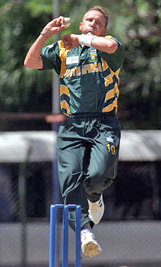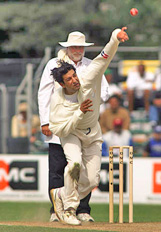COACHING
Cutting Edge
- By Polly Umrigar Considering that bowlers have a hard time in modern-day cricket, it is important that they make the most of all the factors that are within their control. They can deceive the batsmen by expanding their repertoire and mixing up their deliveries. There are also other things that they can do.Bowlers can alter the angle of delivery by 'using the crease'. They could deliver one ball from close to the stumps, the following one from the edge of the crease, and so on. Generally, a bowler goes close to the stumps when he wants to run the ball away outside the off stump, and goes wide of the crease when he wants to push one towards the batsman.

Modern master Allan Donald.
The bowler is said to have 'changed his pace' when
he delivers a ball that is either faster or slower
than his stock delivery. A bowler should vary his
pace in a subtle fashion. He should endeavour to
maintain exactly the same run-up and action when he
decides to change his pace. If he gives it away by
say running in quicker to bowl a faster one, a
quality batsman can easily make out what he is upto.
The objectives of changing pace are to lure the
batsman into playing the wrong stroke, or to
deceive him into playing the correct stroke too
early or too late, and thus prevent him from timing
it well.
To deliver a slower ball, the bowler should push the ball further into his palm. If he wants to deliver a faster one, he should hold the ball with his fingers, with minimal contact with the palm.
Bowlers would also do well to learn to 'flight' the ball. If the ball forms an arc in flight and dips down, it can cause the batsman to hit the ball in the air quite unintentionally. It will also probably bounce a little higher than the normal delivery after pitching, and this increases the possibility of an unwary batsman getting out caught-and-bowled.
To deliver a slower ball, the bowler should push the ball further into his palm. If he wants to deliver a faster one, he should hold the ball with his fingers, with minimal contact with the palm.
Bowlers would also do well to learn to 'flight' the ball. If the ball forms an arc in flight and dips down, it can cause the batsman to hit the ball in the air quite unintentionally. It will also probably bounce a little higher than the normal delivery after pitching, and this increases the possibility of an unwary batsman getting out caught-and-bowled.
'Cutters' constitute an important part of a quick bowler's repertoire. They can play an important part in deceiving a batsman and leading him to his doom.
The 'leg' cutter is like a fast leg-break. The middle or third finger plays an important part in this delivery. The ball 'cuts' from leg to off after pitching. In the 'off' cutter, the index finger plays a significant part and the ball 'cuts' from off to leg after pitching.

Wasim 'Wizard' Akram
In both cases, the seam of the ball touches the
finger that plays a prominent part. At the moment
of release, the hand and fingers 'cut' down the
right side of the ball (of the seam) for off cutter
and the left side for the leg cutter. The great
value of cutters is the speed at which they can be
delivered. The batsman gets hardly any time to make
up his mind.
A combination of physical strength and suppleness apart, fast bowlers should also possess an element of hostility. No fielding captain will complain if his fast bowler looks aggressive as he runs in to deliver the ball! His run-up should be sufficiently long to work up pace. A needlessly long run-up should be avoided, as it is a waste of energy. When the ball is new, a fast bowler should target the stumps with most of their deliveries. The 'bumper' can be an effective 'shock' ball. No batsman likes to face deliveries that are chest-high, shoulder-high or even head-high. It is balls like these that make them play hasty shots.
A combination of physical strength and suppleness apart, fast bowlers should also possess an element of hostility. No fielding captain will complain if his fast bowler looks aggressive as he runs in to deliver the ball! His run-up should be sufficiently long to work up pace. A needlessly long run-up should be avoided, as it is a waste of energy. When the ball is new, a fast bowler should target the stumps with most of their deliveries. The 'bumper' can be an effective 'shock' ball. No batsman likes to face deliveries that are chest-high, shoulder-high or even head-high. It is balls like these that make them play hasty shots.
The ideal 'bumper' is one that rises without being pitched too short. A fast bowler of 6' 3" will be able to bring the ball down from a sharper angle than a man of say 5' 6", and thereby gain more lift from a ball of the same length. The bumper should normally be bowled at full pace to give the batsman hardly any time to think. It should be bowled directly over the stumps, so as to get him caught on the wrong foot, literally!
Fast bowling is a taxing activity, mentally and physically. The legs, back muscles and stomach muscles are stretched to the maximum and hence, a fast bowler has to look after these parts of his body. Ideally, fast bowlers should not be given long spells. Bowling in short spells will enable them to be reasonably fresh when they are brought back after a break.
The 'Yorker' can be as dangerous a delivery as the 'bumper'. The Yorker demands a greater degree of accuracy. It should be aimed at the middle or leg-stump. It becomes even more lethal if the bowler is able to swing the ball.
We all know that bowlers who are marginally slower than out-and-out fast bowlers are called 'medium pacers'. There are some bowlers who are medium-pacers throughout their careers, and there are others who may have started out as fast bowlers, but have become medium-pacers after reaching their early 30s. What a quality medium-pacer doesn't have in terms of speed, he is expected to have in terms of variations.